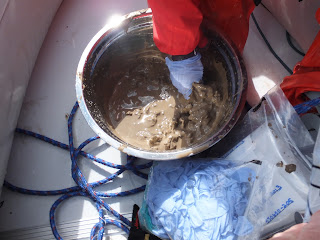It’s
that time of year again when I find myself hearing north. The program for this
year is scaled down in both time and detail from previous years.
(I'm having trouble adding photos, this is par for the course for me, i don't know if it's the internet up here but I'll keep trying.)
·
Day
1 - Outpost Island (N62o44’10”, W113o27’30”) located in
the eastern portion of Great Slave Lake.
·
Day
2 - Blanchet mine on Blanchet Island
(N61o59’45”, W112o23’45”) in the Hearne Channel and
·
Days
3, 4, & 5 - Copper Pass Mine located on Sachawia Lake (N62o24’30”,
W111o51’45”)
·
Day
6 – contingency day (in case we needed to go back to one site) or a day off, whichever
comes first!
There
is an interesting little write up on the mine that can be found at http://www.pwnhc.ca/timeline/1925/1941_Outpostisland.htm
.
We
(Claire Brown, Lloyd Ricky, the wildlife monitor/boat driver and myself) would
leave Yellowknife at 0700h fly to the site, unload the plane, setup the boat,
collect the sediment and water samples, tear the boat down, load the twin
otter, return to Yellowknife unload the plane, load the van, get to the hotel
and spend the next couple of hours processing the samples.
The Archipelago of Outpost Islands.
Our gear; coolers for samples and lunch, firearms
for wildlife protection, zodiac inflatable boat and motor, action packers with:
survival gear (in case the plane does not come back) sampling equipment and a
backup of everything.
The
historic plack.
Our ride back to Yellowknife.
Day
2.
We
(Claire Brown, Lloyd Ricky, the wildlife monitor/boat driver and myself) would
leave Yellowknife at 0700h fly to the site, unload the plane, setup the boat,
collect the sediment and water samples, tear the boat down, load the twin
otter, return to Yellowknife unload the plane, load the van, get to the hotel
and spend the next couple of hours processing the samples. (Note the similarly
to Day 1!)
I cannot
find any information on this mine site; however I do have a few photos.
The set-up of the boat, it takes only about 45
minutes if you have several hands to help.
A typical sediment sample.
The mine adit (opening)
Day
3.
We
(Claire Brown, Lloyd Ricky, the wildlife monitor/boat driver and myself) would
leave Yellowknife at 0700h fly to the site, unload the plane, setup the boat,
collect the water samplesat the end of the day we would load the twin otter,
return to Yellowknife unload the plane, load the van, get to the hotel and
spend the next couple of hours processing the water samples. (almost the same
as Day 2!!!)
Copper
Pass is a mine I have been to before. I was here in 2012, so I won’t recap the
history of the site. This trip we were to collect sediment samples in Sachawia
Lake as well as sediment/soil samples the creek beds along the outfalls from
the main and west showings (mine workings).
The flight into Sachawia Lake.
Our wildlife monitor taking “five” at the former
camp site.
Day
4.
A complete
change of pace, we left Yellowknife at 0700h fly to the site, unload the plane,
the boat was already set-up from the day before, what luck that no bears got at
it, collect the water sediment samples, come the end of the day we would load
the twin otter, return to Yellowknife unload the plane, load the van, get to
the hotel and spend the next couple of hours processing the sediment samples. (almost
the same as Day 2!!!)
The “T” handle sediment sampler, taking samples in the lake.
The drop hammer sampler, taking samples in the lake.
The broken drop hammer sampler coupler, this put an
end to the drop hammer and from then on we had to use the “T” handle.
Day
5.
This
time when we arrived on site we were here to take the samples from the creek
beds running from the main and west showings. This involved a 2km hike through
the misquote infested woods, up and down rock faces and through the marshes.
On the road from Great Slave Lake to the mine site.
Well
the “day off” did not happen, we needed to return to all three sites, there
were sediment samples that we could not get due to 0.5m waves on the lake at
Outpost and Blanchet and had to take from the float of the plane, and there was an inspection that needed to be completed
at Copper Pass.
The
next two days were spent cleaning and packing away the equipment we used during
this field campaign and preparing for the Canol Trail.
While we were unpacking we found one of our radios that had been lost last year at Blanchet Mine, it has been inspected by a bear.
Cheers
for now.




















Just decided to check to see if there were any new posts. SO PROUD of you and super-pleased that you have decided to continue with your blog. :)
ReplyDelete